Importance of Kitchen Ceiling Design
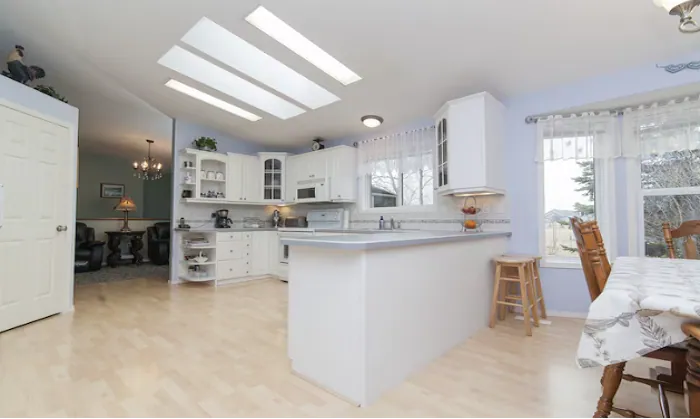
The kitchen, often considered the heart of the home, serves as a central hub for culinary creations and family gatherings. While much attention is typically paid to kitchen cabinets, countertops, and appliances, the significance of kitchen ceiling design should not be overlooked. The ceiling plays a vital role in defining the ambiance, functionality, and overall aesthetic appeal of the kitchen space.
Enhancing Aesthetics and Functionality
A well-designed kitchen ceiling can significantly enhance the overall aesthetics of the space, elevating it from functional to fabulous. By incorporating innovative and stylish ceiling design ideas, homeowners can create a visually stunning environment that reflects their personal style and complements the rest of the kitchen decor. From adding architectural interest to enhancing lighting and creating a sense of spaciousness, the possibilities for enhancing the kitchen ceiling are endless.
Tailoring Designs for Pakistani Kitchens
In this post, we'll delve into the realm of kitchen ceiling design, focusing specifically on innovative and stylish ideas tailored for Pakistani kitchens. Pakistan boasts a rich cultural heritage, characterized by diverse architectural influences, intricate patterns, and vibrant colours. By integrating these cultural elements into kitchen ceiling designs, homeowners can infuse their culinary spaces with a unique sense of identity and charm.
Exploring Innovative Ideas
Throughout this post, we'll explore a variety of innovative ideas for kitchen ceiling design, ranging from tray ceilings and exposed beams to coffered ceilings and vaulted ceilings. Each design concept will be presented with a keen eye towards its suitability for Pakistani kitchen aesthetics, ensuring that homeowners can find inspiration that resonates with their tastes and preferences.
In summary, the kitchen ceiling plays a crucial role in shaping the look, feel, and functionality of the culinary space. By exploring innovative and stylish ceiling design ideas tailored for Pakistani kitchens, homeowners can transform their kitchens into inviting and visually captivating havens where culinary creativity flourishes and cherished memories are made.
Importance of Kitchen Ceiling Design
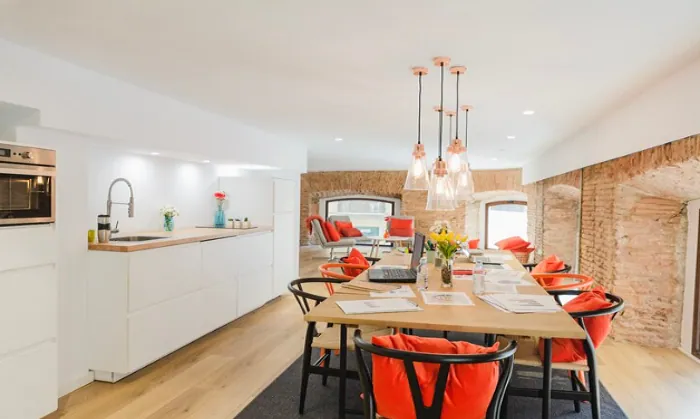
Enhancing Ambiance, Lighting, and Spatial Perception
A well-designed kitchen ceiling serves as more than just a functional element; it acts as a canvas for enhancing the overall ambiance, lighting, and spatial perception of the room. Here's how:
1. Ambiance:
The ceiling sets the tone for the entire kitchen ambiance. By incorporating elements like colour, texture, and architectural features, it can create a cosy, inviting atmosphere or a sleek, modern vibe. For example, a painted ceiling with warm hues can add a sense of warmth and intimacy to the space, while a ceiling with exposed beams evokes a rustic, farmhouse charm.
Proper lighting is essential in any kitchen, and the ceiling plays a crucial role in illuminating the space effectively. Strategic placement of recessed lights, pendant fixtures, or skylights can brighten up the kitchen and create a well-lit environment for cooking, dining, and socializing. Additionally, the ceiling can act as a reflector, bouncing natural or artificial light throughout the room to reduce shadows and enhance visibility.
3. Spatial Perception:
The design of the ceiling can influence how spacious the kitchen feels. For instance, a ceiling with a higher profile, such as a vaulted or tray ceiling, creates a sense of openness and airiness, making the kitchen appear larger than it actually is. On the other hand, a coffered ceiling adds depth and dimension to the space, adding visual interest and breaking up the monotony of a flat ceiling.
Creating a Cohesive and Visually Appealing Decor Scheme
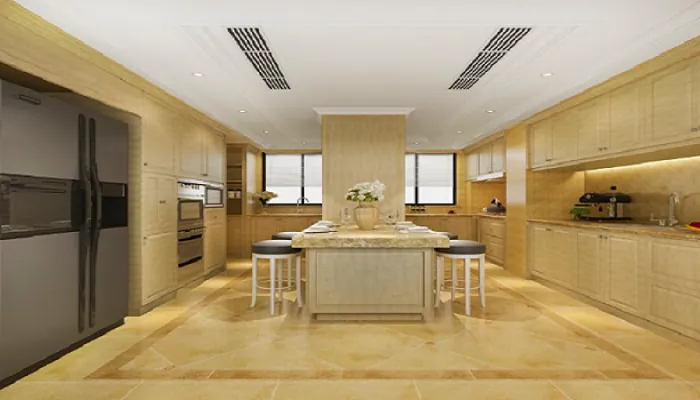
In addition to its functional aspects, the kitchen ceiling also plays a crucial role in tying together the overall decor scheme of the space. Here's how:
1. Cohesiveness:
A well-designed ceiling complements the other elements in the kitchen, such as cabinets, countertops, and flooring, creating a cohesive and harmonious look. By coordinating colours, materials, and design motifs, the ceiling helps unify the various components of the kitchen decor, resulting in a seamless and polished aesthetic.
2. Visual Appeal:
The ceiling serves as a focal point in the kitchen, drawing the eye upward and adding visual interest to the space. Whether adorned with decorative moulding, exposed beams, or intricate patterns, a visually appealing ceiling enhances the overall beauty and elegance of the kitchen, making it a more inviting and enjoyable place to spend time.
In summary, the kitchen ceiling is an integral part of the overall design scheme, contributing to the ambiance, lighting, and spatial perception of the room. By paying attention to its design and aesthetics, homeowners can create a cohesive and visually appealing kitchen decor scheme that enhances the beauty and functionality of the space.
Popular Ceiling Design Trends
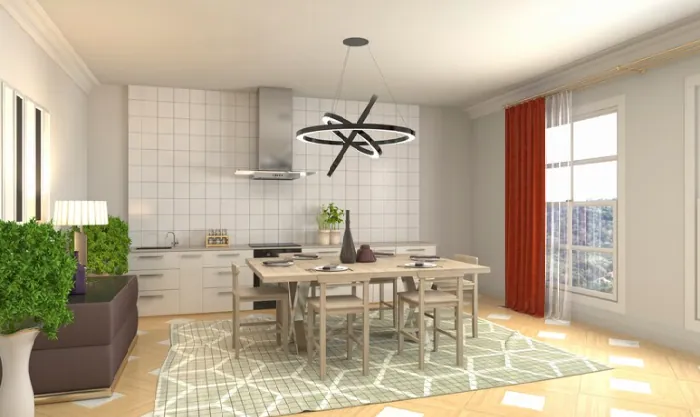
Innovative ceiling designs can transform the look and feel of a kitchen, adding personality, depth, and visual interest to the space. Let's explore some popular ceiling design trends that are making waves in Pakistani kitchens:
1. Tray Ceilings
Tray ceilings are a versatile design feature that adds dimension and depth to the kitchen. These ceilings feature a central section that is elevated or recessed, creating a tray-like effect. Here's why tray ceilings are gaining popularity:
- Dimensional Appeal: Tray ceilings create an illusion of height, making the kitchen feel more spacious and airy.
- Architectural Detailing: They provide an opportunity to incorporate architectural details, such as crown moulding or recessed lighting, adding sophistication to the space.
- Suitability for Pakistani Kitchens: Tray ceiling designs can be tailored to suit Pakistani kitchen aesthetics, blending seamlessly with traditional or contemporary decor styles.
2. Exposed Beams
Exposed ceiling beams add rustic charm and architectural interest to the kitchen, infusing the space with character and warmth. Here's why exposed beams are a popular choice:
- Rustic Charm: Exposed beams evoke a sense of rustic elegance, adding warmth and texture to the kitchen.
- Versatility: Whether made of wood or faux materials, exposed beams can be customized to suit various design preferences and architectural styles.
- Suitability for Pakistani Kitchens: Exposed beam designs can be adapted to complement Pakistani kitchen aesthetics, incorporating traditional craftsmanship and detailing.
3. Coffered Ceilings
Coffered ceilings exude luxury and elegance, creating a visually striking focal point in the kitchen. Here's why coffered ceilings are coveted by homeowners:
- Luxurious Aesthetic: Coffered ceilings add a touch of opulence to the kitchen, elevating its overall aesthetic appeal.
- Architectural Sophistication: They showcase intricate detailing and craftsmanship, enhancing the kitchen's architectural beauty.
- Suitability for Pakistani Kitchens: Coffered ceiling designs can be inspired by Pakistani architectural motifs and detailing, infusing the kitchen with cultural richness and heritage.
4. Vaulted Ceilings
Vaulted ceilings create a sense of drama and spaciousness in the kitchen, making it feel grand and expansive. Here's why vaulted ceilings are sought after:
- Dramatic Impact: Vaulted ceilings make a bold statement, instantly drawing the eye upward and adding drama to the kitchen.
- Maximized Vertical Space: They maximize vertical space, allowing for tall cabinets, larger windows, and ample natural light.
- Suitability for Pakistani Kitchens: Vaulted ceiling designs can be adapted to Pakistani kitchen layouts, optimizing space while enhancing the kitchen's architectural beauty.
In summary, these popular ceiling design trends offer homeowners in Pakistan a plethora of options to elevate their kitchen spaces. Whether opting for tray ceilings, exposed beams, coffered ceilings, or vaulted ceilings, each trend brings its own unique charm and personality to the kitchen, transforming it into a stylish and inviting culinary haven.
Functional Considerations in Kitchen Ceiling Design
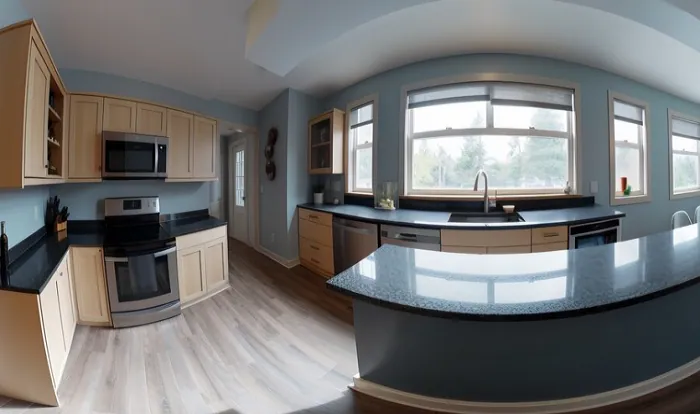
Designing a kitchen ceiling involves more than just aesthetics; it requires careful consideration of practical aspects to ensure functionality and comfort. Here's how to address key functional considerations in kitchen ceiling design:
Lighting Placement
Proper lighting is essential in the kitchen to facilitate cooking tasks, enhance visibility, and create ambiance. When designing the ceiling, consider the placement of lighting fixtures to achieve optimal illumination. Here are some tips:
- Task Lighting: Install recessed lights or pendant fixtures directly above work areas, such as the countertop and stove, to provide focused task lighting.
- Ambient Lighting: Incorporate ambient lighting, such as flush-mount fixtures or track lighting, to evenly illuminate the entire kitchen space and reduce shadows.
- Accent Lighting: Add accent lighting, such as LED strips or under-cabinet lights, to highlight architectural features or decorative elements.
Ventilation
Proper ventilation is crucial for maintaining air quality and removing cooking doors, smoke, and excess moisture from the kitchen. Consider the following ventilation options when designing the ceiling:
- Range Hood Placement: Position the range hood centrally above the cooking area to effectively capture and vent out cooking fumes and doors.
- Ductwork Integration: Plan for ductwork pathways within the ceiling to accommodate exhaust vents connected to the range hood or exhaust fans.
Acoustic Considerations
The kitchen can be a noisy environment, especially during meal preparation and social gatherings. Addressing acoustic considerations in the ceiling design can help mitigate noise and create a more comfortable atmosphere. Here's how:
- Sound-Absorbing Materials: Choose ceiling materials with acoustic properties, such as acoustic tiles or panels, to absorb sound and reduce reverberation.
- Insulation: Install proper insulation in the ceiling cavity to dampen sound transmission between floors and rooms, enhancing acoustic comfort.
Integration of Functional Elements
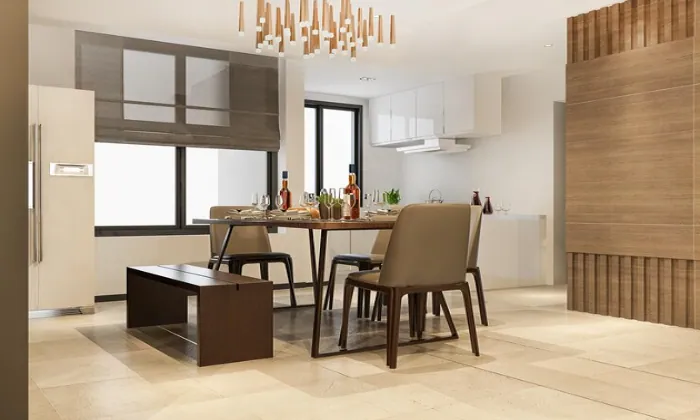
Integrating functional elements seamlessly into the overall ceiling design is key to achieving both functionality and aesthetics. Here are some tips for ensuring a harmonious integration:
- Concealed Fixtures: Opt for recessed lighting fixtures or flush-mount vents to maintain a clean and streamlined ceiling appearance.
- Built-In Features: Incorporate built-in speakers, sprinkler systems, or motion sensors discreetly within the ceiling design to minimize visual clutter.
- Coordination with Design Elements: Coordinate the placement and finish of functional elements with other design features, such as cabinetry, countertops, and flooring, to create a cohesive look.
By addressing practical aspects such as lighting placement, ventilation, and acoustic considerations, and integrating functional elements seamlessly into the overall ceiling design, homeowners can create a kitchen space that not only looks beautiful but also functions efficiently and enhances the overall cooking and dining experience.
Incorporating Cultural Elements into Kitchen Ceiling Design
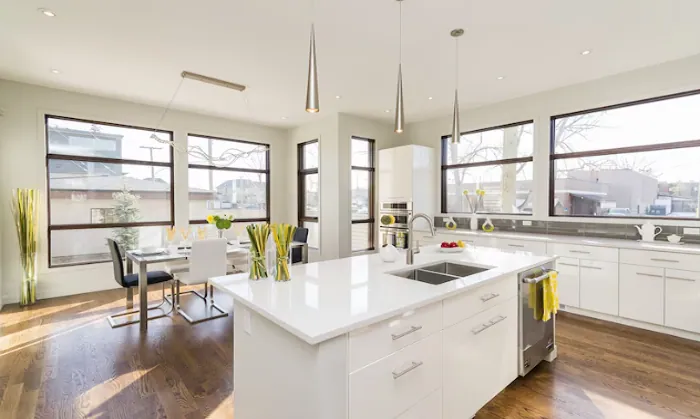
Pakistan boasts a rich cultural heritage characterized by diverse influences, intricate patterns, and vibrant colors. Infusing Pakistani cultural elements into kitchen ceiling design adds a unique touch of identity and charm to the space. Let's explore some creative ways to incorporate these cultural elements:
Intricate Patterns
Incorporating intricate patterns inspired by Pakistani culture can lend a sense of elegance and sophistication to the kitchen ceiling. Traditional motifs such as paisleys, floral, and arabesques can be translated into stunning ceiling designs. These patterns can be hand-painted or stencilled onto the ceiling surface, creating a visually captivating focal point.
Islamic Geometric Motifs
Islamic geometric motifs hold deep cultural significance and are renowned for their intricate beauty. Incorporating these motifs into the kitchen ceiling design adds a touch of cultural richness and symbolism to the space. Geometric patterns such as stars, arabesques, and tessellations can be intricately carved or embossed onto the ceiling, creating mesmerizing visual effects.
Traditional Crafts
Pakistan is renowned for its rich tradition of craftsmanship, encompassing a wide range of traditional crafts such as woodcarving, tile work, and pottery. Integrating these traditional crafts into the kitchen ceiling design celebrates Pakistan's artisanal heritage. Hand-carved wooden panels, intricately patterned tiles, or hand-painted ceramics can be used to adorn the ceiling, adding a touch of authenticity and craftsmanship to the space.
Showcase of Culturally Inspired Designs
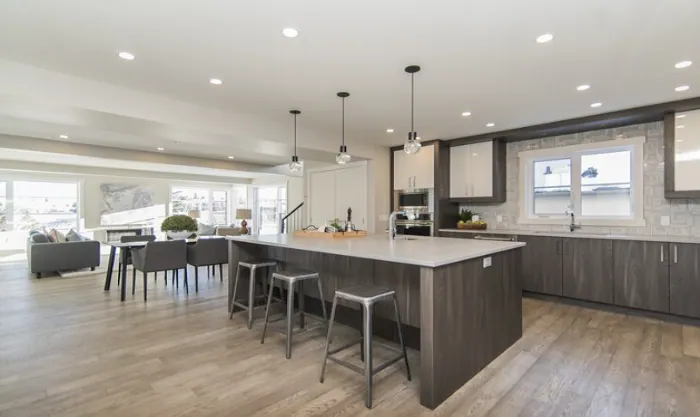
To inspire homeowners, let's showcase some examples of culturally inspired ceiling designs that celebrate Pakistan's rich heritage and craftsmanship:
- Mughal-Inspired Ceilings: Intricately carved wooden panels featuring Mughal-inspired motifs such as arabesques, floral patterns, and geometric designs.
- Tile Work Ceilings: Ceilings adorned with colourful ceramic tiles featuring traditional Pakistani patterns such as kashi kari, blue pottery, or truck art motifs.
- Hand-Painted Ceilings: Hand-painted ceilings featuring scenes from Pakistani culture and tradition, such as landscapes, folk dances, or architectural landmarks.
By infusing Pakistani cultural elements such as intricate patterns, Islamic geometric motifs, and traditional crafts into kitchen ceiling design, homeowners can create a space that reflects their cultural identity and pays homage to Pakistan's rich heritage and craftsmanship. These culturally inspired designs add depth, character, and authenticity to the kitchen, transforming it into a truly unique and inviting culinary haven.
Conclusion
In conclusion, the kitchen ceiling design significantly influences the ambiance and functionality of the space, from enhancing lighting and spatial perception to reflecting cultural identity. Embrace the creative possibilities of incorporating intricate patterns, Islamic motifs, and traditional crafts to infuse your kitchen with Pakistani heritage. Let your ceiling design be a reflection of your unique style and cultural identity, transforming your kitchen into a stylish and functional culinary haven. Explore the endless possibilities and turn your kitchen into a space that truly feels like home.
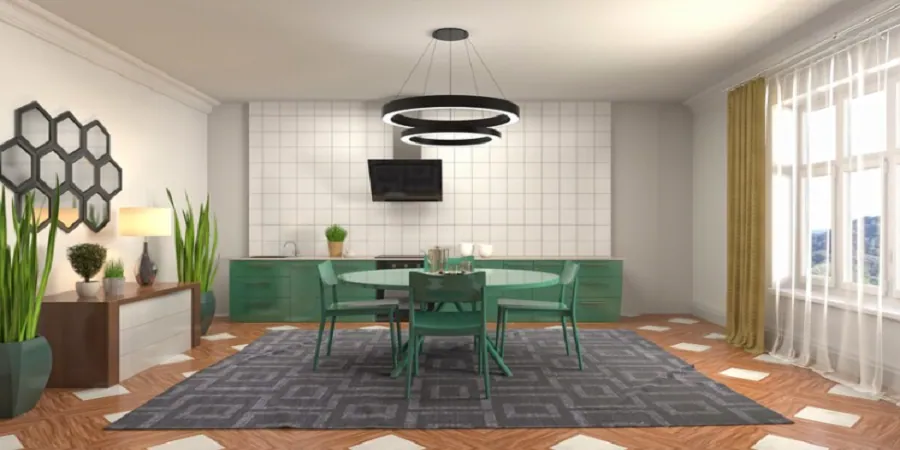
Comments